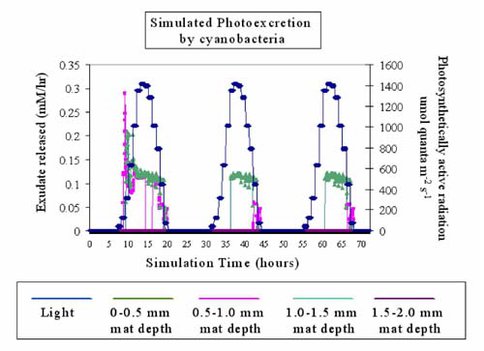2007 Annual Science Report
 NASA Ames Research Center
Reporting | JUL 2006 – JUN 2007
NASA Ames Research Center
Reporting | JUL 2006 – JUN 2007
Ecosystem to Biosphere Modeling
Project Summary
Project Progress
We refined the methanogenesis model in the process of producing a manuscript for publication; however several key constraints remain undefined and are necessary to complete the model. We don’t know the rate that non-competitive substrates are released for uptake by methanogens in the mat. We do not know the mortality rate of the methanogens and we also do not know the extent which oxygen damages them. Specifically, it is known that oxygen has a toxic effect, but the extent is unknown. We ran 50-60 simulations to balance out these unknown constraining factors in an attempt to reach 1) a meaningful doubling time, and 2) an equilibrium population. The results did not correspond closely with rough estimates of population sizes of methanogens in Guerrero Negro. There was some discussion of using population estimates from another portion of the mat, but coauthors disagreed with the approach based of mat discrepancies. There was also discussion of using methanogenesis rate data to back-calculate substrate release rates. This will happen after the empirical data are evaluated.
The initial version of our microbial ecosystem model did not explicitly consider the migration of live microbial cells upward as dead cells and other organic matter pools were created. Without this migration, the mat would become increasingly dense and light would not penetrate. Thus we modeled the burial of DM in this version assuming an upward accretion rate attributable to cell growth and migration of 1 cm/year (Farmer and Richardson 1988).
We began modeling of photoexcretion by cyanobacteria in the microbial mat. If mat O2:CO2 ratios > 1 within a given layer, then we assume that photorespiration occurs resulting in the production of glycolate, which is a common excretion product. If this condition is met, 11.8% of net photosynthesis goes into the exudates pool, which is used as substrates for sulfate-reducing bacteria and methanogens.
-
PROJECT INVESTIGATORS:
-
PROJECT MEMBERS:
Kelly Decker
Co-Investigator
-
RELATED OBJECTIVES:
Objective 4.1
Earth's early biosphere
Objective 5.3
Biochemical adaptation to extreme environments
Objective 6.1
Environmental changes and the cycling of elements by the biota, communities, and ecosystems
Objective 7.2
Biosignatures to be sought in nearby planetary systems
